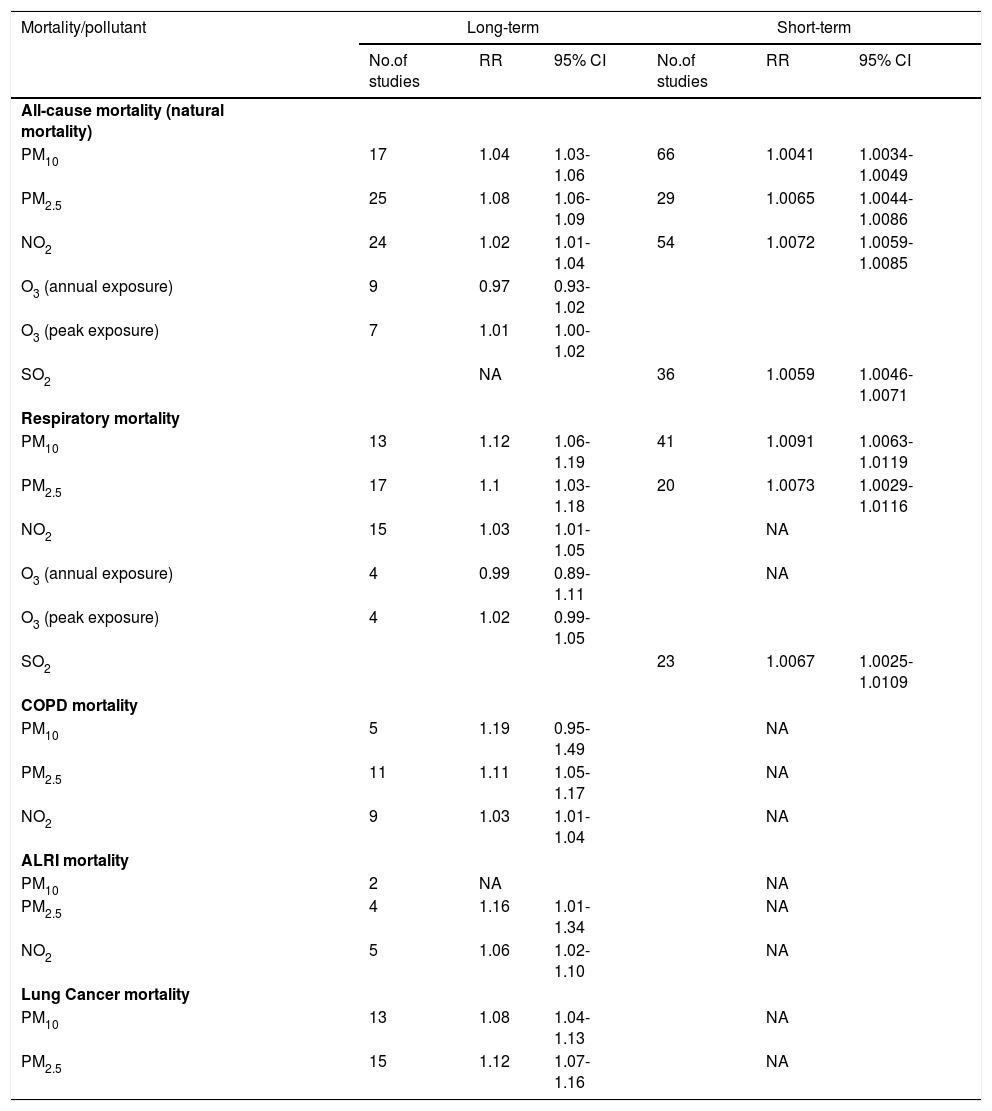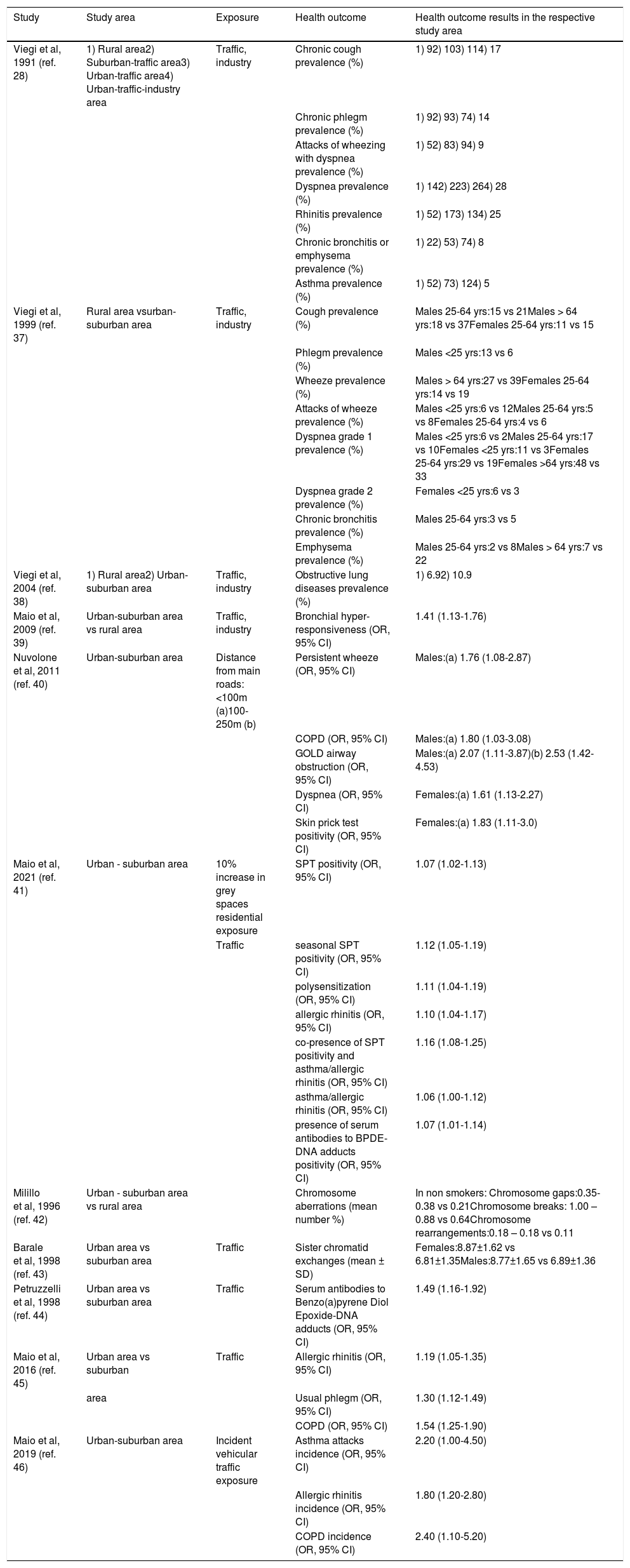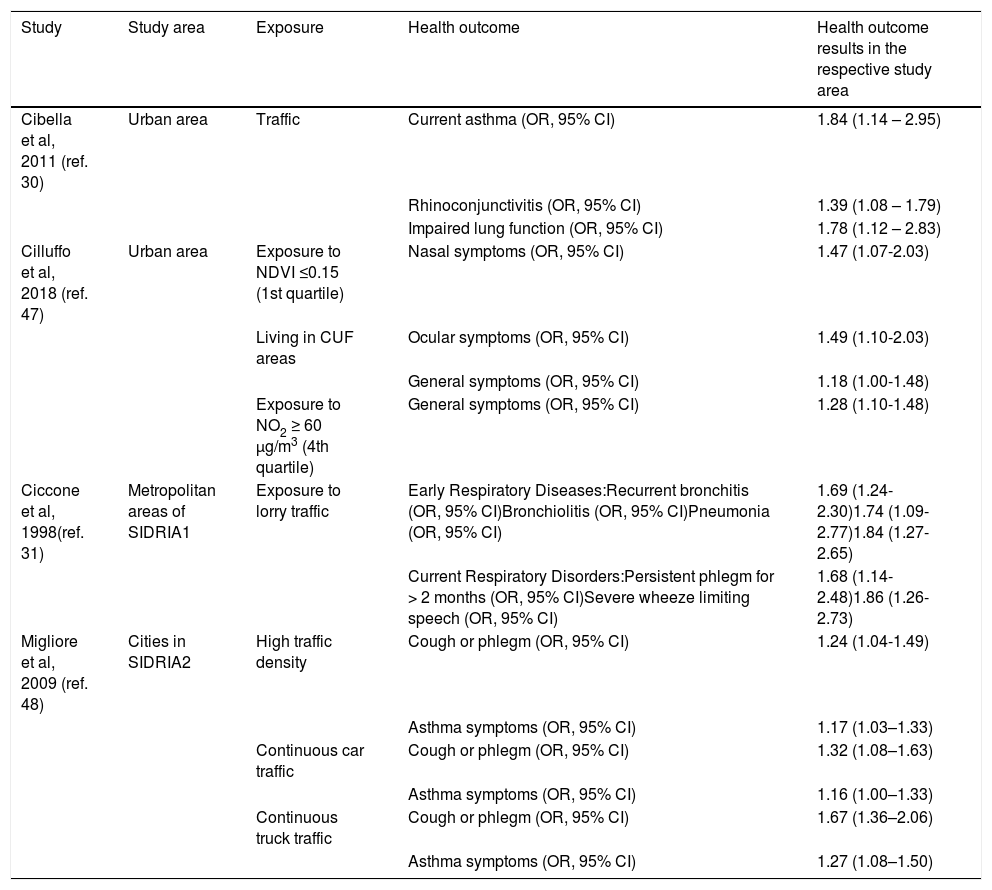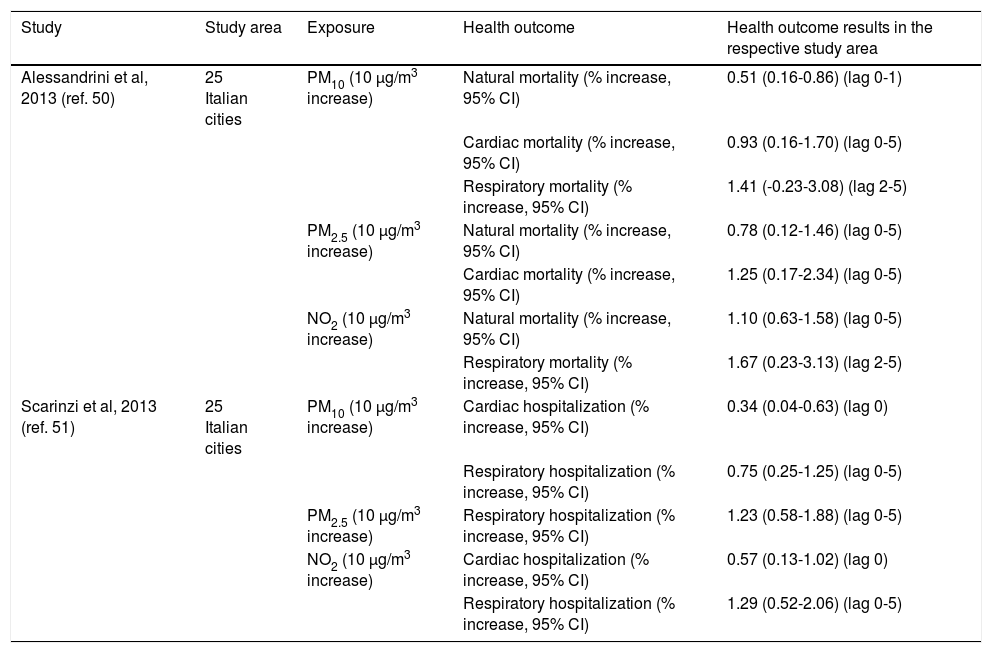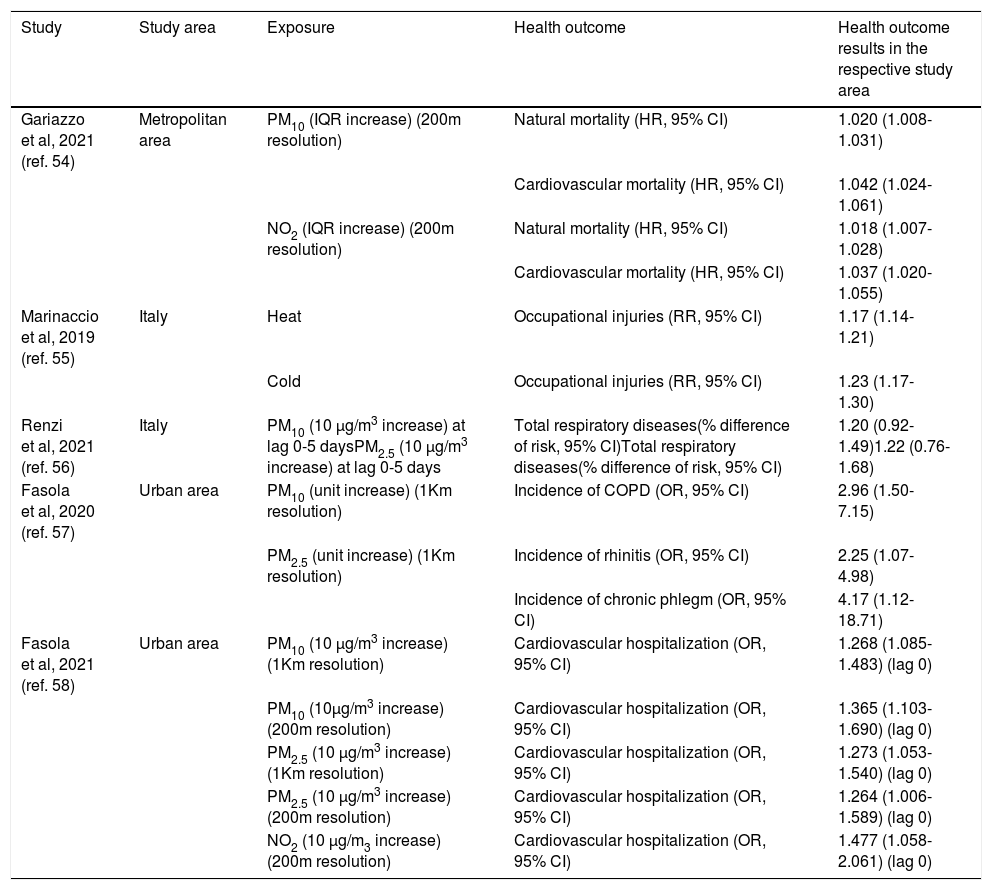to summarize the main updated evidence about the health effects of air pollution and to focus on Italian epidemiological experiences on the respiratory effects.
Resultsthe recent literature indicates that there is strong evidence for causal relationships between PM2.5 air pollution exposure and all-cause mortality as well as mortality from acute lower respiratory infections, ischaemic heart disease, stroke, chronic obstructive pulmonary disease, and lung cancer. A growing body of evidence also suggests causal relationships with type II diabetes and impacts on neonatal mortality from low birth weight and short gestation as well as neurologic effects in both children and adults. Italy, a Southern European country, faces a more threatening air pollution challenge because of the effects of both anthropogenic pollutants and natural dust (particulate matter, PM). The 2020 Report of the European Environment Agency highlighted the number of premature deaths in Italy attributable to main pollutants: 52,300 for PM2.5, 10,400 for NO2 and 3,000 for O3 in 2018. In Italy, original time series and analytical epidemiological studies showed increased cardio-respiratory hospital admissions and mortality and increased risk of respiratory diseases in people living in urban areas.
Conclusionsadverse health effects of air pollutants, even at low levels, have been confirmed by recent epidemiological studies. Further studies should focus on the potential link between air pollution exposure and respiratory infections. This topic has become particularly important in the current SARS-COV-2 pandemic.
Based on strong scientific evidence, the Italian government, which hosts the Global Alliance against Chronic Respiratory Diseases (GARD)-Italy at the Ministry of Health, the scientific respiratory societies and the patients’ associations, as well as others in the health sector and civil society, must increase their engagement in advocacy for clean air policies, especially in light of the new Air Quality Guidelines of the World Health Organization.
Air pollution is the leading environmental risk factor worldwide. Ambient and household air pollution together currently rank 4th for attributable disease and mortality among 20 major risk factors evaluated in the Global Burden of Disease (GBD) study, only after hypertension, smoking and dietary factors.1 The World Health Organization (WHO) estimates indicate that around 7 million deaths, mainly from non-communicable diseases, are attributable to the joint effects of ambient and household air pollution, with the greatest attributable disease burden seen in low and middle-income countries.2,3 A recent investigation indicates that regions with large anthropogenic contributions had the highest attributable deaths, suggesting substantial health benefits from replacing traditional energy sources.4
The recent literature indicates that there is strong evidence for causal relationships between PM2.5 air pollution exposure and all cause-mortality as well as acute lower respiratory infections (ALRI), ischaemic heart disease (IHD), stroke, chronic obstructive pulmonary disease (COPD), and lung cancer.1 A growing and suggestive body of evidence also suggests a relationship with asthma, type II diabetes and impacts on neonatal mortality from low birth weight and short gestation as well as neurologic effects in both children and adults.5,6
The need to be informed on health effects of air pollution is reinforced by the Air quality in Europe - 2020 Report of the European Environment Agency (EEA) (https://www.eea.europa.eu/publications/air-quality-in-europe-2020-report), which highlighted the number of premature deaths in Italy attributable to main pollutants: 52,300 for particulate matter with an aerodynamic diameter less than 2.5 μm (PM2.5), 10,400 for nitrogen dioxide (NO2) and 3,000 for ozone (O3) in 2018.
The peculiarity of Southern Europe, according to the EEA report, is to be affected by higher concentrations of outdoor air pollutants, as well as by higher percentage increases in mortality associated with 10 μg/m3 increase in PM compared to other European areas.7
In addition, an adverse situation for the Mediterranean countries is the presence of desert sand dust, which can be high for many days in the year. For example, in Italy, the number of days with high African dust (up to 100 μg/m3) ranges from 17% in the Po River Valley to 37% in Palermo, Sicily.8
Indeed, each 10 μg/m3 increase in desert sand PM10 (particulate matter with an aerodynamic diameter less than 10 μm) is associated with increased all-cause and cardiovascular mortality, as well as respiratory hospital admissions for children and adolescents (2.38%, 95% CI: 0.09 – 4.71).9
The aims of this paper are: 1) to summarize the recent international evidence on the link between air pollution exposure and respiratory effects published after the ERS/ATS statement in 2017.5 This updated information will be crucial to setting the context and future avenues for action; 2) to disseminate the results obtained in Italy when dealing with the issue of health effects of air pollution, especially useful for clinical readers.
MethodsThis paper is divided into two main topics, a general update and the Italian perspective: the first one provides recent (from 2018 to 2021) quantitative estimates of the health impact due to air pollution at a global level; the second one is a confirmation at national level of the findings obtained at international level, summarizing results of different Italian epidemiological studies carried out during the last 40 years.
General updateIn order to update the available evidence on respiratory health effects of outdoor air pollution after the 2017 ERS/ATS statement,5 it was decided to focus on systematic reviews that also performed a meta-analysis to provide quantitative estimates of the associated public health impact. From an online literature search of PubMed and Embase databases from 2018 to June 2021 using the following search terms ‘outdoor air pollution’ and ‘respiratory health’ and ‘meta-analysis’, 16 articles were retrieved.10-25 The English language was also an inclusion criterion.
After the articles’ full-text screening, one study was discarded because it evaluated a non-respiratory outcome,10 one for considering indoor air exposure only,16 one for not being a systematic review,15 and three for not reporting meta-analytic estimates for respiratory health effects.13,20,22 Among the remaining ten articles included, six evaluated overall respiratory mortality.11,12,17,18,19,23
Italian perspectiveThe Italian perspective can be seen as the confirmation at the national level of the findings obtained at the international level and used for elaborating the relevant documents of the major scientific societies, utilized by WHO for issuing air quality guidelines (AQG).
The first part of this section, which is built upon a recent publication of the Authors,26 reports the main results from the studies conducted by or in collaboration with the National Research Council in Italy: the Po Delta and Pisa analytical epidemiological studies on health effects of air pollution,27,28,29 the Palermo studies on children-adolescents,30 and the SIDRIA study.31
The second part of this section reports the main results from the use of health and environment routine statistics carried out by a large collaborative multicenter study (the EPIAIR study).32
The last part, which is the most innovative, describes the outcome of the BEEP project, based on the use of big data and artificial intelligence.33
ResultsGeneral updateWHO has updated its Global Air Quality Guidelines, the final document has been published on September 22, 2021.34 In anticipation, a series of systematic reviews investigating associations between a range of air pollutants and human health outcomes had been conducted. Table 1 summarizes the results for the systematic reviews that have evaluated exposure to various pollutants and mortality (all causes mortality as well as mortality from respiratory diseases, COPD, ALRI, and lung cancer).12,18,23
Association between long-term and short-term exposure to specific pollutants and mortality.
Systematic reviews for the update WHO AQG. Relative risks (RR) are per 10 µg/m3 exposure.
ALRI: Acute Lower Respiratory Infection
NA: not available
One meta-analysis provided quantitative global estimates for overall respiratory mortality for long-term exposure to particulate matter (PM2.5 and PM10).12 There was clear evidence that PM2.5 was associated with significantly increased mortality from respiratory diseases (mainly, asthma and COPD) and lung cancer. Only a few studies included in the meta-analysis were conducted in the so-called low-income countries (LIC).
This positive association between PM and respiratory mortality was also confirmed in a meta-analysis that evaluated short term exposure for all main pollutants, including NO2 and O3; increased risks emerged for both PM10 (relative risk-RR: 1.0091; 95% CI: 1.0063-1.0119), and PM2.5 (RR: 1.0073; 95% CI: 1.0029-1.0116).23
Of note, another meta-analysis, focused on short-term exposure to PM2.5 and PM10 originating from biomass burning (BB), did not find a significant positive association with respiratory mortality, but only with respiratory morbidity. The pooled effect estimates were 4.10% (95% CI: 2.86-5.34) and 4.83% (95% CI: 0.06-9.60) increased risk of total respiratory admissions/emergency visits per 10 μg/m3 increases in PM2.5 and PM10, respectively. In particular, COPD rates increased by 3.92% (95% CI: 1.13-6.70) and 3.95% (95% CI: 1.65-6.24) per 10 μg/m3 increases in BB-related PM2.5 and PM10, respectively. Similarly, for adult asthma admissions/visits, the pooled estimate for both PM2.5 and PM10 was 9.59% (95% CI: 6.53-12.24). Interestingly, the evidence was less consistent for pediatric asthma: 3.52% (95% CI: -2.13-9.18) per 10 μg/m3 increase in PM2.5 or PM10.19
All three meta-analyses, focused on long-term NO2 exposure and respiratory mortality,11,17,18 found a significant positive association with respiratory mortality, but with evidence of substantial heterogeneity among the included studies. In detail, one meta-analysis pooling cohort studies only estimated a hazard ratio (HR) of 1.03 (95% CI: 1.01-1.05) for respiratory mortality, and of 1.05 (95% CI: 1.02-1.08) for lung cancer mortality per 10 μg/m3 increment in NO2 concentration.11 A subsequent similar meta-analysis found that a 10 μg/m3 increase in NO2 was associated with a RR of 1.03 (95% CI: 1.01-1.05) for respiratory mortality. In addition, this study found a significant positive association for COPD (RR: 1.03; 95% CI: 1.01-1.04) and ALRI (RR: 1.06; 95% CI: 1.02-1.10) mortality.18 The most recent meta-analysis estimated a pooled HR for respiratory mortality per 10 ppb increase in annual NO2 concentrations of 1.05 (95% CI: 1.02-1.08), confirmed also in multi-pollutant models suggesting an independent effect of NO2 on mortality.17
Among the four meta-analyses that focused on specific respiratory outcomes only,14,21,24,25 one study evaluated the association of O3 short-term exposure with asthma exacerbations.21 Ozone exposures measured as 1-hour (RR: 1.012; 95% CI: 1.005-1.019) or 8-hour (RR: 1.011; 95% CI: 1.007-1.014) daily max were more consistently associated with asthma exacerbations, both in adults and children, than the 24-hour average (RR: 1.005; 95% CI: 0.996-1.014) exposure during the warm season. Another meta-analysis focused on COPD risk for NO2 exposure;25 the pooled effects, per 10 μg/m3 increase in NO2 concentration, were 17% on prevalence, 1.3% on hospital admissions, and 2.6% on mortality. The RR of COPD related to NO2 long-term exposure was 2.5%, whilst for short-term exposure was 1.4%. The COPD effects associated with a 10 μg/m3 increase were 1.7% for exposure to a general outdoor-sourced NO2 and 17.8% for exposure to an exclusively traffic-sourced NO2; importantly, the effect of NO2 on COPD mortality emerged mainly in lag 0 models. Another recent meta-analysis, evaluating long term exposure to main air pollutants and COPD incidence, found a positive association per 10 μg/m3 increase in PM2.5 (pooled HR: 1.18; 95% CI: 1.13-1.23), and in NO2 (pooled HR: 1.07; 95% CI: 1.00-1.16), but not in PM10.24
Finally, a meta-analysis evaluated the relationship between PM exposure and lung function decline.14 The study estimated that a 10 μg/m3 increase in short-term PM2.5 exposure (days) was associated with a −7.02 mL (95% CI: −11.75 to –2.29) change in the forced expiratory volume in 1 second (FEV1). A 10 μg/m3 difference in long-term PM10 exposure was associated with a −8.72 mL (95% CI: −15.39 to –2.07) annual change in FEV1 and an absolute difference in FEV1 of −71.36 mL (95% CI: −134.47 to –8.24).
O3 remained the least evaluated air pollutant: acute exposure was found associated only with asthma exacerbations in both adults and children.21 In terms of specific respiratory outcomes, asthma and COPD were the most evaluated diseases, both for incidence, exacerbations, and mortality. For asthma incidence, the available evidence of a positive association with air pollution is stronger among children than adults, even if a just published large international study adds new supporting evidence.35 The authors estimated HRs for adult-onset asthma of 1.22 (95% CI: 1.04–1.43) per 5 μg/m3 for PM2.5, 1.17 (95% CI: 1.10-1.25) per 10 μg/m3 for NO2 and 1.15 (95% CI: 1.08-1.23) per 0.5×10−5/m−1 for black carbon exposure. For COPD, increasing evidence supports a positive association, and emerging evidence links it to long term NO2 exposure.24,25 The positive association with lung cancer mortality was confirmed and linked not only to PM,11 but also to NO2 long-term exposure.11
Italian perspectiveI) Analytical epidemiological surveys
In Italy, two major analytical longitudinal surveys on general population samples were conducted from 1980 to 2011. The first was in Po River Delta, a rural area near Venice, before and after the construction of a large oil-burning central power plant. The second was in Pisa and its surrounding area, before and after the construction of a new highway far from the residential zones.27,28,29,36 This epidemiological investigation used subjective (e.g. standardized questionnaire on respiratory symptoms, diseases and risk factors) and objective tools (e.g. lung function tests, bronchial responsiveness, skin prick tests, serum immunoglobuline E (IgE), inflammation and mutagenetic biomarkers).
The results of the epidemiological surveys on general population samples living in Po Delta and Pisa are summarized in Table 2.
Air pollution effects in Italy: I) analytical epidemiological surveys (Po Delta and Pisa studies carried out by CNR).
OR: odds ratio; COPD: chronic obstructive pulmonary disease; GOLD: Global Initiative for Chronic Obstructive Lung Disease.
In the early nineties, it became clear that living in the city was associated with more respiratory symptoms and diseases than living in the rural area.28,29,37,38 Those living in the city had higher bronchial responsiveness as measured by a methacholine dose-response challenge.39 In particular, city residents had a 41% increased risk of developing airway hyper-responsiveness compared to rural residents. The 41% increase in city-dwellers was similar to the 39% increased risk shown by smokers compared to never smokers.39
A cross-sectional spatial analysis of the effects of traffic-related air pollution was carried out in the urban and suburban areas of Pisa, Italy.40 The house of each participating subject was geo-referenced and people were stratified into three groups according to the distance from the main road: less than 100 meters, 100-250 meters, more than 250 meters. People who lived closest to the traffic had significantly increased risks of respiratory symptoms and diseases and airflow obstruction, as measured by FEV1/forced vital capacity (FVC). More recently, it was shown that a 10% increase in grey space residential exposure (assessed using CORINE Land cover classes) was significantly related to a higher probability of having allergic biomarkers/conditions and presence of serum antibodies to benzo(a)pyrene diol epoxide-DNA (BPDE-DNA) adducts.41
The chromosome aberrations (CA) frequency, determined in three samples of healthy individuals (60 living in a rural area (Po Delta), 134 in Pisa downtown and 116 in Cascina, a small town near Pisa), was statistically significantly higher in the Pisa sample than in the Po Delta sample.42 Sister chromatid exchanges (SCE), determined in lymphocytes cultures from 2000 participants, were significantly higher in the urban than in the suburban area.43 Urban residents were also 49% more likely to have increased serum antibodies to BPDE-DNA adducts, compared to suburban residents.44
Three cross-sectional surveys conducted in Pisa and suburbs from 1985 to 2011 have shown increased prevalence rates of respiratory symptoms and diseases, especially allergic rhinitis. Living in the urban area was associated with increased risks for allergic rhinitis (+19%), cough (+14%), phlegm (+30%), and COPD (+54%), compared to those living in the suburban area.45
The 18-year cumulative incidence of respiratory and allergic symptoms, diseases and risk factors from the Pisa epidemiological study was published in 2019. The cumulative incidence values ranged from 3.2% for asthma to 31.7% for allergic rhinitis. The incidence of vehicular traffic exposure yielded significantly increased risks for the incidence of asthma attacks (+120%), allergic rhinitis (+80%), and COPD (+140%).46
The results of the epidemiological surveys on pediatric population samples living in Palermo and other Italian cities are summarized in Table 3.
Air pollution effects in Italy: I) analytical epidemiological surveys (other studies with CNR collaboration).
NDVI: normalized difference vegetation index; CUF: continuous urban fabric; OR: odds ratio.
A total of 2150 Italian schoolchildren were cross-sectionally investigated through respiratory questionnaire, SPT, and spirometry in Palermo, Sicily.30 A proportional Venn diagram quantified the distribution of current asthma, rhinoconjunctivitis, and eczema. Avoiding exposures to measured environmental risk factors would prevent 41% of current asthma (15.1% considering only traffic) and 34% of rhinoconjunctivitis (7.8% considering only traffic); avoidance of traffic would also prevent 14.1% of impaired lung function.
More recently, the effects of “green”, “grey” and air pollution exposure were simultaneously assessed on respiratory/allergic conditions and general symptoms in Palermo schoolchildren.47 Exposures to greenness and greyness at the home addresses were measured using the normalized difference vegetation index (NDVI), residential surrounding greyness (RSG) and the CORINE land-cover classes (CLC, divided in “discontinuous urban fabric - DUF” - and “continuous urban fabric - CUF”). A very low exposure to NDVI ≤ 0.15 (1st quartile), living in CUF areas, living in proximity (≤200 m) to High Traffic Roads (HTRs), and high exposure to NO2 (≥ 60 μg/m3) were associated with nasal, ocular or general symptoms.
The group at CNR also collaborated in the realization of the Italian branch of the International Study on Asthma and Allergies in Childhood (ISAAC), which was named SIDRIA from the acronym of the name in Italian standing for Italian Studies on Pediatric Respiratory Disturbances and the Environment.
The first population-based survey (SIDRIA1) was conducted in 10 areas of Northern and Central Italy (1994-1995) in two age groups (6-7 and 13-14 years) (n= 39,275).31 In the metropolitan areas, a high frequency of truck traffic in the street of residence was associated with significantly increased risks for many adverse respiratory outcomes. Among early respiratory diseases, significantly increased risks were found for recurrent bronchitis (+69%), bronchiolitis (+74%) and pneumonia (+84%), as well as for current respiratory symptoms such as persistent phlegm for > 2 months (+68%), and severe wheeze limiting speech (+86%).
The 2nd survey (SIDRIA2) was conducted in 2002 in 12 centers in Northern, Central and Southern Italy, on 33,632 children and adolescents (6-7 and 13-14 years old). Overall traffic density was associated with asthma symptoms but there was a stronger association with cough or phlegm (high traffic density: excess risk of 24%). Car and truck traffic were independently associated with asthma symptoms and cough or phlegm.48
II) Use of routine statistics
The results of epidemiological studies using routine statistics in some Italian cities are summarized in Table 4.
Air pollution effects in Italy: II) use of routine statistics.
A large multicenter study using routinely collected statistics has been carried out in several cities throughout Italy, with the collaboration of CNR. The first survey, EPIAIR (from the acronym of the Italian name standing for Air pollution and health: epidemiological surveillance and prevention interventions), was conducted in ten cities in the period 2001-2005.32,49
More recently, the study has been enlarged to include data on 25 cities (EPIAIR2) during the period 2006-2010. An immediate effect of PM10 on natural mortality was found. More relevant and prolonged effects (lag 0-5) were found for PM2.5 and NO2. Increases in cardiac mortality were associated with PM10 and PM2.5, while exposure to NO2 as well as PM10 had an important role in respiratory mortality.50
Furthermore, the study has analyzed 2,246,448 urgent hospital admissions for non-accidental diseases in 25 Italian cities during the period 2006-2010. A relationship to an increment of 10 µg/m3 of air pollutants was estimated. Increases in cardiac and respiratory hospitalizations were associated with PM10 and NO2.51
Notably, pollution reduction actions as prescribed by the European Union legislation, i.e. a 20% reduction up to 20 µg/m3 for PM10 and up to 18 µg/m3 for PM2.5, would have saved, overall the cities covered by this study, 42% and 51% of all attributable deaths, respectively.52
III) Use of big data
One of the biggest challenges of modern environmental epidemiology is being able to collect and link, in a complex way, large amounts of geographical, environmental and health data, to obtain comprehensive information otherwise not available. Within this context, the Italian National Insurance Institute against Work-related Accidents (INAIL) has funded a project named “Big data in environmental and occupational epidemiology" (BEEP) (acronym from the Italian “Big data in Epidemiologia ambiEntale ed occuPazionale”) (2017-2019).
The main goal of the BEEP project has been to estimate, through BIGDATA methodology, the health effects of air pollution, noise and meteorological parameters on the Italian general population. The project consists of specific objectives focused on different special domains, from the whole nation to the urban micro-scale.
Some publications have been so far realized: their results are summarized in Table 5.
Air pollution effects in Italy: III) the use of big data.
IQR: interquartile range; HR: hazard ratio; RR: relative risk; OR: odds ratio; COPD: chronic obstructive pulmonary disease
One has dealt with the improvement of the estimation of NO2, O3, PM2.5 and PM10 concentrations in 6 Italian metropolitan areas, using chemical-transport and machine learning models, and assessment of the exposure effect on population by using information on urban population mobility.53
Another paper has aimed to compare the effect estimates of the long-term exposure of air pollutants on cause-specific mortality in the Rome Longitudinal Study, using exposure estimates obtained with different modelling techniques and spatial resolutions (from 4 m to 1 Km). All the exposures were assigned to the residential addresses of 482,259 citizens of Rome 30+ years of age who were enrolled in 2001 and followed up until 2015. Natural cause and cardiovascular diseases (CVD) mortality outcomes were all positively associated with the interquartile range (IQR) of NO2 and PM10 with a tendency of larger effect for lower resolution exposures.54
A nationwide epidemiological study has also been carried out to estimate the risk of injuries for workers exposed to extreme temperatures and identify economic sectors and jobs most at risk. The study considered 2,277,432 occupational injuries occurred in Italy in the period 2006-2010 and showed a significant increase of occupational injury for heat and cold exposure.55
Nationwide data of air pollution from PM and daily hospitalizations for respiratory diseases in Italy have been recently published.56 A total of 4,154,887 respiratory admissions were registered during 2006-2015, of which 29% for lower respiratory tract infections, 12% for COPD, 6% for upper respiratory tract infections, and 3% for asthma. Daily mean PM10 and PM2.5 concentrations over the study period were 23.3 and 17 µg/m3, respectively. Excess risks of total respiratory diseases, stronger for asthma and COPD, in association with a μg/m3 PM10 increase were found. Higher effects were reported in the elderly and in less urbanized areas. In addition, the compliance with a theoretical daily PM10 standard of 25 µg/m3, a value suggested by 2005 WHO annual guideline, would have avoided about 4,900 respiratory admissions. Similarly, a total of 8,917 admissions were attributable to PM2.5 daily concentrations exceeding 10 µg/m3 in 2013-2015.
Using data from the longitudinal analytical epidemiological study in Pisa, individual risk factors recorded during the 1991 survey were considered, and new cases of respiratory diseases were ascertained until 2011. Average PM10 and PM2.5 exposures (µg/m3, year 2011) were estimated at the residential address (1-km2 resolution) on the subsample of subjects living at the same address from 1991 to 2011. Significantly increased risks of incidences of rhinitis and chronic phlegm were associated with increasing PM2.5 and an increased risk of incidence of COPD was associated with increasing PM10.57
In another recently published study in Pisa, exposure effects were estimated using the case-crossover design and conditional logistic regression (OR 95% CI for 10 μg/m3 increase; lag 0-6). During the period 2013-2015 (69 cardiovascular hospitalizations), significant effects at lag 0 were observed for PM10 and PM2.5 at 1 km resolution, as well as for PM2.5 and NO2 at 200 m resolution; significant effects were observed up to lag 2. Larger ORs were observed in males and in subjects reporting pre-existent cardiovascular/respiratory diseases.58
The results of the BEEP project, beyond opening new scientific research perspectives which are being pursued within the ongoing INAIL - BIGEPI project (https://bigepi.it/index.php/en/), have provided useful indications for public decision-makers in the field of air quality, planning of urban environments and public health protection.
DiscussionGeneral updateWe acknowledge that the approach to the literature search was not systematic and there was no formal qualitative appraisal of the retrieved evidence; however, we have summarized below some considerations, and suggestions for future research in the field.
Among the included meta-analyses, when bi/multi-pollutants models were used pooled risk estimates generally decreased or lost statistical significance, due to known high correlation between air pollutants. No evaluation of specific PM compositions, especially as adsorbed toxicants, was performed. Toxicity assessment of PM is currently typically based on mass concentration rather than the physicochemical properties of the constituents, and this may hamper evaluation of underlying etiopathogenetic pathways of respiratory diseases.
A few studies evaluated dose-response relationships; usually, they appeared linear and with no threshold identified of no effect as previously reported,59 highlighting the concept that even in countries where governmental exposure limits are enforced, no safe levels of air pollution exist.
There was a limited adjustment for potential confounders. For example, in relation to COPD risk, an important effect of adjustment for occupational exposures was reported in air pollution studies60 as a key determinant of socioeconomic status. Among the included meta-analyses, less than half of them were adjusted or restricted for occupational confounders.12,18,19,23,24 High heterogeneity between studies emerged, especially among those evaluating long term NO2 exposure,11,17,18 making pooled estimates less reliable. Identification of variability sources via meta-regression was hampered by the limited number of included studies.
Studies conducted in LICs are still limited both in quality and quantity of available data.12 Instead, further studies in these countries should be encouraged given the likely higher level of pollution from industrial sources and lack of stringent air pollution regulations.61 Also, further studies should focus on the potential link between air pollution exposure and respiratory infection diseases. Only one meta-analysis reported estimates for infectious outcomes.12 This topic has become particularly important in the current SARS-COV-2 pandemic which has generated the debated hypothesis that air pollution may act as a booster and even a carrier of the virus, so increasing infection susceptibility and severity and subsequent mortality from the COVID-19 disease.62 Further research on how these two silent killers interact in increasing global morbidity and mortality is warranted.
Italian perspectiveThe Global Alliance against chronic Respiratory Diseases (GARD) was launched in Beijing on March 28, 2006, as a partnership among the WHO, governmental institutions, scientific societies and patients’ associations. The GARD motto is “a world where all people breathe freely.” Air pollution is one of the most important risk factors to health and reducing it is a priority for the prevention and control of chronic respiratory diseases.63
The GARD initiative in Italy was launched on June 11, 2009, at the Ministry of Health, which assumed the role of national coordinator. Its main objective is to promote the development of a coordinated Chronic Respiratory Diseases program in Italy. Effective prevention implies setting up health policies against tobacco smoking, indoor/outdoor pollution, obesity, and communicable diseases, with the support of healthcare professionals and citizen associations at national, regional, and district levels. Respiratory diseases prevention cannot and should not be the responsibility of doctors alone, but must involve politicians/policymakers, as well as the media, local institutions, and schools.64 The Italian government, GARD, scientific societies, and other members of the health community must increase their engagement in advocacy for clean air.
Awareness of environmental exposures is increasing in the general population and assisted by the use of the risk charts, such as those for COPD elaborated in collaboration with the National Institute of Health.65 The charts let people calculate their risk of getting COPD in the next ten years, based on gender, age, smoking habits and environmental exposures.
ConclusionsAir pollution is an avoidable health risk that places a great burden on society in terms of death and health disorders, at a huge social and economic cost. Within Europe, the southern countries face a difficult situation because they experience the effects of anthropogenic and natural air pollution.
The air quality standards of the EU are laxer than the WHO AQG published in 2005 and studies have shown significant health effects even below the most stringent current standard. The differences between the EU and the WHO recommended values are now much larger after the publication of the new WHO AQG33 on September 22, 2021, indicating levels that are largely lower than the previous ones.
Based on abundant evidence, the Italian government, which hosts the Global Alliance against Chronic Respiratory Diseases (GARD)-Italy at the Ministry of Health, the scientific respiratory societies and the patients’ associations, as well as others in the health sector and in civil society, must increase their engagement in advocacy for clean air policies, especially in light of the new WHO AQG.



